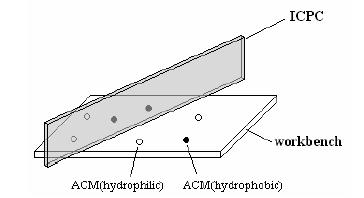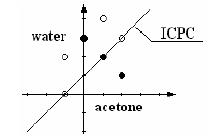【极角排序、扫描线】UVa 1606 - Amphiphilic Carbon Molecules(两亲性分子)
Shanghai Hypercomputers, the world's largest computer chip manufacturer, has invented a new class of nanoparticles called Amphiphilic Carbon Molecules (ACMs). ACMs are semiconductors. It means that they can be either conductors or insulators of electrons, and thus possess a property that is very important for the computer chip industry. They are also amphiphilic molecules, which means parts of them are hydrophilic while other parts of them are hydrophobic. Hydrophilic ACMs are soluble in polar solvents (for example, water) but are insoluble in nonpolar solvents (for example, acetone). Hydrophobic ACMs, on the contrary, are soluble in acetone but insoluble in water. Semiconductor ACMs dissolved in either water or acetone can be used in the computer chip manufacturing process.
As a materials engineer at Shanghai Hypercomputers, your job is to prepare ACM solutions from ACM particles. You go to your factory everyday at 8 am and find a batch of ACM particles on your workbench. You prepare the ACM solutions by dripping some water, as well as some acetone, into those particles and watch the ACMs dissolve in the solvents. You always want to prepare unmixed solutions, so you first separate the ACM particles by placing an Insulating Carbon Partition Card (ICPC) perpendicular to your workbench. The ICPC is long enough to completely separate the particles. You then drip water on one side of the ICPC and acetone on the other side. The ICPC helps you obtain hydrophilic ACMs dissolved in water on one side and hydrophobic ACMs dissolved in acetone on the other side. If you happen to put the ICPC on top of some ACM particles, those ACMs will be right at the border between the water solution and the acetone solution, and they will be dissolved. Fig.1 shows your working situation.

Your daily job is very easy and boring, so your supervisor makes it a little bit more challenging by asking you to dissolve as much ACMs into solution as possible. You know you have to be very careful about where to put the ICPC since hydrophilic ACMs on the acetone side, or hydrophobic ACMs on the water side, will not dissolve. As an experienced engineer, you also know that sometimes it can be very difficult to find the best position for the ICPC, so you decide to write a program to help you. You have asked your supervisor to buy a special digital camera and have it installed above your workbench, so that your program can obtain the exact positions and species (hydrophilic or hydrophobic) of each ACM particle in a 2D pictures taken by the camera. The ICPC you put on your workbench will appear as a line in the 2D pictures.

Input
There will be no more than 10 test cases. Each case starts with a line containing an integer N, which is the number of ACM particles in the test case. N lines then follow. Each line contains three integers x, y, r, where (x, y) is the position of the ACM particle in the 2D picture and r can be 0 or 1, standing for the hydrophilic or hydrophobic type ACM respectively. The absolute value of x, y will be no larger than 10000. You may assume that N is no more than 1000. N = 0 signifies the end of the input and need not be processed. Fig.2 shows the positions of ACM particles and the best ICPC position for the last test case in the sample input.
Output
For each test case, output a line containing a single integer, which is the maximum number of dissolved ACM particles.
Sample Input
3
0 0 0
0 1 0
2 2 1
4
0 0 0
0 4 0
4 0 0
1 2 1
7
-1 0 0
1 2 1
2 3 0
2 1 1
0 3 1
1 4 0
-1 2 0
0 【题意】 给定平面上的n个点,分别为黑色和白色,现在需要放置一条隔板,使得隔板一侧的白点数目加上另一侧的黑点总数最大。隔板上的点可以看做是在任意一侧; 【分析】 贪心策略:假设隔板一定经过至少两个点; 方法:①暴力枚举--先枚举两个点,然后输出两侧黑白点的个数。复杂度O(n^3).90%会TLE...;
②先找一个基准点,让隔板绕该点旋转。每当隔板扫过一个点就动态修改两侧的点数。在此之前,需对所有点相对于基准点(即将基准点看做(0,0))进行极角排序。复杂度O(n^2*logn);
【NOTE】 极角排序:通俗的说,就是根据坐标系内每一个点与x轴所成的角,逆时针比较,。按照角度从小到大的方式排序。用到的函数是atan2(y, x);
扫描线:这个概念也比较好理解。注意动态维护的时候细节问题(代码中会有详解,当然只针对自己这种第一次接触看不懂人家代码的菜)。
小技巧:因题目要求求两侧不同颜色的点数和,可以预处理将黑点做中心对称。这样原本位于两侧的黑白点的点就会分布在同一侧内了(真心巧妙。。。);
【代码】
#include<iostream>
#include<cstdio>
#include<cstdlib>
#include<cmath>
#include<algorithm>
using namespace std;
const int maxn = ;
struct Node
{
int x, y;
double rad;
int col;
bool operator < (const Node& a) const
{
return rad < a.rad;
}
}node[maxn], tnode[maxn];
int Cross(Node a, Node b)
{
return (a.x*b.y - b.x*a.y) >= ;
}
int main()
{
//freopen("out.txt", "w", stdout) ;
int n, ans, cnt = ;
while(scanf("%d", &n) && n)
{
ans = ;
for(int i = ; i < n; i++)
{
scanf("%d%d%d", &node[i].x, &node[i].y, &node[i].col);
}
if(n <= ) {printf("%d\n", n); continue;}
cnt = ;
for(int basicp = ; basicp < n; basicp++) //基准点
{
for(int i = ; i < n; i++) //各点相对于基准点的坐标
{
if(i == basicp) continue;
tnode[cnt].x = node[i].x-node[basicp].x;
tnode[cnt].y = node[i].y-node[basicp].y;
if(node[i].col) {tnode[cnt].x = -tnode[cnt].x; tnode[cnt].y = -tnode[cnt].y;} //对黑点中心对称
tnode[cnt].rad = atan2(tnode[cnt].y, tnode[cnt].x); //求极角
cnt++;
}
sort(tnode, tnode+cnt); //极角排序。几何意义为由x轴正半轴逆时针旋转;
int l = , r = ; //l, r:求tnode[l~r]之间的点
int sum = ; //注意这个sum = 2;
while(l < cnt)
{
if(r == l) //主要针对初始情况
{
r=(r+)%cnt; sum++;
}
while(l != r&&Cross(tnode[l],tnode[r])) //Cross(tnode[l],tnode[r]) 叉积:若小于0则两点的夹角大于180度。跳出循环
{
r=(r+)%cnt; sum++;
}
sum--; //sum-1主要是为了在枚举新的起点时减去老的起点。而初始sum=2也是为了符合这一条件
l++; //枚举新的起点
ans=max(ans,sum);
}
}
cout << ans << endl;
}
return ;
}
【总结】 看代码很明显又是看了别人的。希望能长个教训吧,以后遇到类似的题自己能独立写出来、
【极角排序、扫描线】UVa 1606 - Amphiphilic Carbon Molecules(两亲性分子)的更多相关文章
- UVA 1606 Amphiphilic Carbon Molecules 两亲性分子 (极角排序或叉积,扫描法)
任意线可以贪心移动到两点上.直接枚举O(n^3),会TLE. 所以采取扫描法,选基准点,然后根据极角或者两两做叉积比较进行排排序,然后扫一遍就好了.旋转的时候在O(1)时间推出下一种情况,总复杂度为O ...
- uva 1606 amphiphilic carbon molecules【把缩写写出来,有惊喜】(滑动窗口)——yhx
Shanghai Hypercomputers, the world's largest computer chip manufacturer, has invented a new classof ...
- UVA - 1606 Amphiphilic Carbon Molecules 极角扫描法
题目:点击查看题目 思路:这道题的解决思路是极角扫描法.极角扫描法的思想主要是先选择一个点作为基准点,然后求出各点对于该点的相对坐标,同时求出该坐标系下的极角,按照极角对点进行排序.然后选取点与基准点 ...
- UVA - 1606 Amphiphilic Carbon Molecules (计算几何,扫描法)
平面上给你一些具有黑或白颜色的点,让你设置一个隔板,使得隔板一侧的黑点加上另一侧的白点数最多.隔板上的点可视作任意一侧. 易知一定存在一个隔板穿过两个点且最优,因此可以先固定以一个点为原点,将其他点中 ...
- UVa 1606 Amphiphilic Carbon Molecules (扫描法+极角排序)
题意:平面上有 n 个点,每个点不是黑的就是白的,现在要放一个隔板,把它们分成两部分,使得一侧的白点数加上另一侧的黑点数最多. 析:这个题很容易想到的就是暴力,不妨假设隔板至少经过两个点,即使不经过也 ...
- UVa 1606 - Amphiphilic Carbon Molecules
链接: https://uva.onlinejudge.org/index.php?option=com_onlinejudge&Itemid=8&page=show_problem& ...
- UVA - 1606 Amphiphilic Carbon Molecules(两亲性分子)(扫描法)
题意:平面上有n(n <= 1000)个点,每个点为白点或者黑点.现在需放置一条隔板,使得隔板一侧的白点数加上另一侧的黑点数总数最大.隔板上的点可以看做是在任意一侧. 分析:枚举每个基准点i,将 ...
- 【UVa】1606 Amphiphilic Carbon Molecules(计算几何)
题目 题目 分析 跟着lrj学的,理解了,然而不是很熟,还是发上来供以后复习 代码 #include <bits/stdc++.h> using namespace std; ; stru ...
- POJ 2280 Amphiphilic Carbon Molecules 极角排序 + 扫描线
从TLE的暴力枚举 到 13313MS的扫描线 再到 1297MS的简化后的扫描线,简直感觉要爽翻啦.然后满怀欣喜的去HDU交了一下,直接又回到了TLE.....泪流满面 虽说HDU的时限是2000 ...
随机推荐
- JDBC学习笔记(10)——调用函数&存储过程
如何使用JDBC调用存储在数据库中的函数或存储过程: * 1.通过COnnection对象的prepareCall()方法创建一个CallableStatement * 对象的实例,在使用Con ...
- hdu 3038 How Many Answers Are Wrong
http://acm.hdu.edu.cn/showproblem.php?pid=3038 How Many Answers Are Wrong Time Limit: 2000/1000 MS ( ...
- Objective-C的singleton模式
最近因为在ios应用开发中,考虑到一些公共方法的封装使用,就决定使用单例模式的写法了..不知道,Object-c中的单例模式的写法是否和java中的写法是否有所区别?于是阿堂从网上一搜,发现“ Obj ...
- JdbcTemplate增删改查
1.使用JdbcTemplate的execute()方法执行SQL语句 jdbcTemplate.execute("CREATE TABLE USER (user_id integer, n ...
- jsp验证码点击刷新
<img src="<%=basePath%>manage/code" alt="验证码" height="20" ali ...
- Xdebug的使用
1.http://www.cnblogs.com/mo-beifeng/articles/2446142.html 2.http://www.cnblogs.com/ximu/articles/200 ...
- skyline TerraBuilder 制作MPT方法与技巧(1)
MPT是skyline独有的三维地形数据格式,可简单理解为 影像图+高程=三维地形(三维底图),以下介绍用skyline TerraBuilder(以下简称TB)制作MPT的方法与技巧 用TB制作MP ...
- EasyUI改动DateBox和DateTimeBox的默认日期格式
近期整理Easyui控件的时候,对Easyui的DateBox控件和DateTimeBox控件进行了梳理,而我之所以将EasyUI的DateBox控件和DateTimeBox控件放在一起,归为一类,是 ...
- Delphi2010下的FillChar
在delphi2010中,因为unicode的原因,FillChar使用方法已经和老版delphi大不相同了. 如果想用某一个字符(或汉字)填充内存 buf: array[0..1023] of Ch ...
- 使用安卓读取sqlite数据库方法记录
最近要实现android读取sqlite数据库文件,在这里先做一个英汉字典的例子.主要是输入英语到数据库中查询相应的汉语意思,将其答案输出.数据库采用sqlite3. 如图: 实现过程完全是按照参考文 ...
